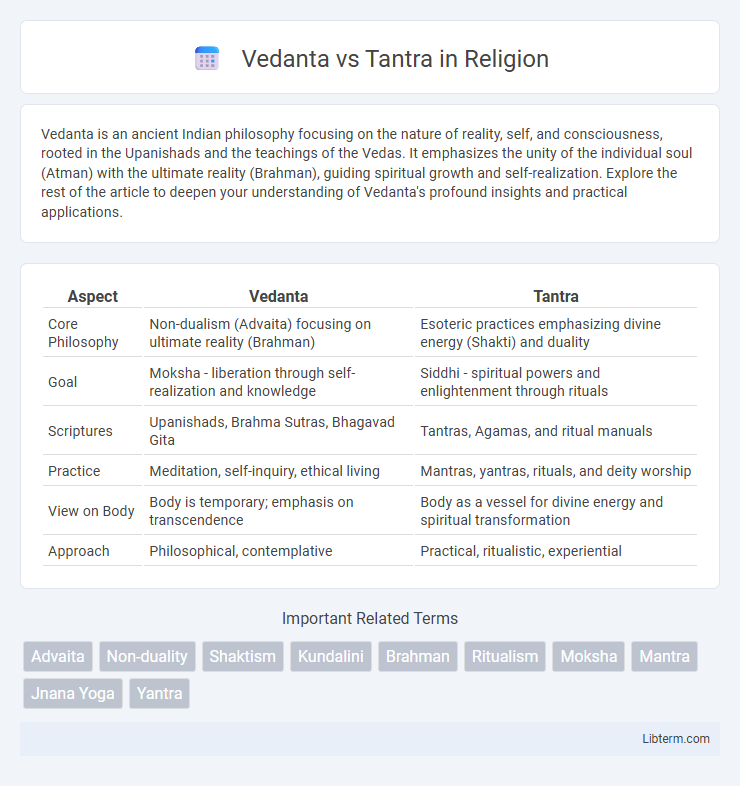Vedanta is an ancient Indian philosophy focusing on the nature of reality, self, and consciousness, rooted in the Upanishads and the teachings of the Vedas. It emphasizes the unity of the individual soul (Atman) with the ultimate reality (Brahman), guiding spiritual growth and self-realization. Explore the rest of the article to deepen your understanding of Vedanta's profound insights and practical applications.
Table of Comparison
| Aspect | Vedanta | Tantra |
|---|---|---|
| Core Philosophy | Non-dualism (Advaita) focusing on ultimate reality (Brahman) | Esoteric practices emphasizing divine energy (Shakti) and duality |
| Goal | Moksha - liberation through self-realization and knowledge | Siddhi - spiritual powers and enlightenment through rituals |
| Scriptures | Upanishads, Brahma Sutras, Bhagavad Gita | Tantras, Agamas, and ritual manuals |
| Practice | Meditation, self-inquiry, ethical living | Mantras, yantras, rituals, and deity worship |
| View on Body | Body is temporary; emphasis on transcendence | Body as a vessel for divine energy and spiritual transformation |
| Approach | Philosophical, contemplative | Practical, ritualistic, experiential |
Introduction to Vedanta and Tantra
Vedanta is a profound Indian philosophy rooted in the Upanishads, emphasizing the realization of the ultimate reality, Brahman, and the unity of the individual soul (Atman) with it. Tantra, on the other hand, is a diverse spiritual tradition that utilizes rituals, meditation, and esoteric practices to harness cosmic energies and achieve spiritual liberation. Both systems offer distinct paths to self-realization, with Vedanta focusing on knowledge and renunciation, while Tantra integrates sensory experiences and energy work.
Historical Origins of Vedanta and Tantra
Vedanta, rooted in the Upanishads dating back to around 800-400 BCE, emphasizes metaphysical knowledge and the realization of Brahman as the ultimate reality. Tantra emerged later, approximately in the mid-1st millennium CE, incorporating esoteric rituals, symbolic practices, and a focus on Shakti or divine feminine energy. While Vedanta's historical origin centers on philosophical inquiry and Vedic texts, Tantra developed as a diverse spiritual tradition blending ritual, mysticism, and theologies outside mainstream Vedic orthodoxy.
Core Philosophical Differences
Vedanta centers on the realization of Brahman as the ultimate, unchanging reality, emphasizing knowledge (jnana) and self-inquiry to achieve Moksha or liberation from the cycle of rebirth. Tantra explores the dynamic interplay of divine cosmic energies (Shakti) and often employs ritualistic practices, meditation, and esoteric techniques to transform the practitioner's consciousness and attain spiritual empowerment. Core philosophical differences lie in Vedanta's non-dualism (Advaita) or qualified non-dualism (Vishishtadvaita), which stresses onmless absolute reality, versus Tantra's embrace of both form and formlessness, viewing the material and spiritual worlds as inherently interconnected and equally sacred.
Vedanta: Fundamental Concepts and Practices
Vedanta explores the nature of reality through core concepts such as Brahman (the ultimate, unchanging reality), Atman (the inner self), and Maya (illusion or cosmic ignorance). It emphasizes self-realization and liberation (moksha) through knowledge (Jnana), meditation, and ethical living, drawing extensively on scriptures like the Upanishads and Bhagavad Gita. Vedanta teachings focus on understanding the unity between Atman and Brahman, aiming to transcend the illusions of the material world and attain spiritual enlightenment.
Tantra: Fundamental Concepts and Practices
Tantra emphasizes the integration of the divine feminine (Shakti) with the divine masculine (Shiva) through ritualistic practices, mantra chanting, and meditation aimed at spiritual liberation and transcendence of duality. Central concepts include Kundalini awakening, chakras, and the use of yantras as symbolic tools to access higher consciousness. Unlike Vedanta's focus on non-dual Brahman and knowledge (jnana), Tantra utilizes experiential techniques and sacred energy manipulation to achieve enlightenment.
Paths to Self-Realization: Vedanta vs. Tantra
Vedanta emphasizes self-realization through knowledge (Jnana Yoga) and discernment of the true self (Atman) as non-different from Brahman, using scriptures like the Upanishads and Bhagavad Gita for guidance. Tantra focuses on direct experience and transformation via rituals, mantras, and meditation to awaken Kundalini energy and unite the individual soul with the cosmic consciousness. While Vedanta prioritizes intellectual understanding and renunciation, Tantra integrates physical practices and esoteric techniques to accelerate spiritual awakening.
Rituals and Techniques: A Comparative Study
Vedanta emphasizes meditation, self-inquiry, and study of sacred texts like the Upanishads to attain liberation, with minimal reliance on external rituals. Tantra involves elaborate rituals, mantras, and yantras, integrating physical practices and deity worship to harness spiritual energies for transformation. Vedanta's techniques foster inner realization through knowledge (jnana), whereas Tantra uses ritualistic and symbolic actions to directly influence consciousness and reality.
Influence on Modern Spirituality
Vedanta's influence on modern spirituality is evident through its emphasis on non-dualism and self-realization, inspiring contemporary mindfulness and meditation practices worldwide. Tantra contributes a complementary dimension by promoting the integration of body, energy, and consciousness, shaping modern holistic healing and yoga techniques. Together, these philosophies enrich contemporary spiritual movements with diverse approaches to inner transformation and awakening.
Misconceptions and Controversies
Vedanta and Tantra are often misunderstood due to misconceptions that Tantra involves only esoteric rituals and sensuality, while Vedanta is perceived as purely philosophical and ascetic. This oversimplification ignores Tantra's profound metaphysical teachings and Vedanta's diverse interpretations spanning dualism, non-dualism, and qualified non-dualism. Controversies arise from these simplified views, leading to debates about orthodoxy, spirituality, and the legitimacy of tantric practices within mainstream Hinduism.
Choosing a Path: Vedanta or Tantra?
Choosing between Vedanta and Tantra depends on one's spiritual goals and temperament. Vedanta emphasizes self-realization through knowledge of the ultimate reality (Brahman) and the pursuit of liberation (moksha) via meditation and philosophical inquiry. Tantra focuses on harnessing divine energy through rituals, mantras, and symbolic practices to attain spiritual empowerment and worldly success.
Vedanta Infographic

 libterm.com
libterm.com